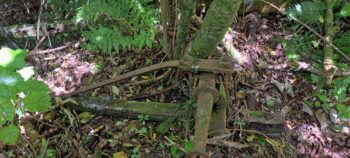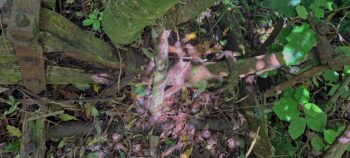 This old log arch cart lies hidden in the bush of Reservoir Valley, serving as a historical relic of the area’s past. It was likely utilised by the Sinclair family to transport logs from what was once known as Sinclair Valley to one of their sawmills near the junction of Moores Valley Road and Whitcher Grove. Later, during the area’s use as a water catchment for the local water supply, the cart may have been repurposed to carry pipes, marking its continued utility beyond the logging era.
This old log arch cart lies hidden in the bush of Reservoir Valley, serving as a historical relic of the area’s past. It was likely utilised by the Sinclair family to transport logs from what was once known as Sinclair Valley to one of their sawmills near the junction of Moores Valley Road and Whitcher Grove. Later, during the area’s use as a water catchment for the local water supply, the cart may have been repurposed to carry pipes, marking its continued utility beyond the logging era.
Today, these carts are often preserved in museums or as historical artefacts, serving as reminders of early logging practices and the role of animals in powering the logging industry.
 A typical log arch cart from the 1800s was a sturdy, practical tool designed for hauling heavy logs through rugged forest terrain. Its defining feature was an arched frame, usually made of hardwood or iron, which allowed one end of a log to be lifted off the ground, reducing drag and making transport more efficient. Large wooden wheels with iron rims provided durability and the ability to navigate uneven terrain. The cart was equipped with a manual winch or block-and-tackle system to lift logs, secured with chains or ropes, and a long tongue connected it to a team of draft horses for pulling.
A typical log arch cart from the 1800s was a sturdy, practical tool designed for hauling heavy logs through rugged forest terrain. Its defining feature was an arched frame, usually made of hardwood or iron, which allowed one end of a log to be lifted off the ground, reducing drag and making transport more efficient. Large wooden wheels with iron rims provided durability and the ability to navigate uneven terrain. The cart was equipped with a manual winch or block-and-tackle system to lift logs, secured with chains or ropes, and a long tongue connected it to a team of draft horses for pulling.
 Built from durable materials like local hardwood and reinforced with metal, these carts were robust yet simple in design for ease of use and repair. They were highly versatile, capable of handling logs of various sizes, and their compact structure made them suitable for tight forest paths. Log arch carts also minimise environmental damage compared to dragging logs directly on the ground.
Built from durable materials like local hardwood and reinforced with metal, these carts were robust yet simple in design for ease of use and repair. They were highly versatile, capable of handling logs of various sizes, and their compact structure made them suitable for tight forest paths. Log arch carts also minimise environmental damage compared to dragging logs directly on the ground.
Credits
Special thanks to Scott Farrell for pointing out the log cart’s location.
Special thanks to Tony Weir for his research into identifying the type of log cart.














